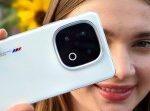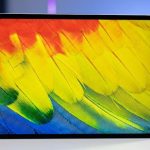Small displays like smartwatches and AR/VR applications are about to get a lot better, at least if Porotech has anything to do with it. Whereas regular LED displays have their red, green, and blue pixels side-by-side, in separate pixels, Porotech’s DynamicPixelTuning (DPT) tech promises to make every pixel capable of outputting all colors. The theory is that this gives displays four times the resolution in the same package; great in situations where the screens are very close to the human eye, such as in the head-mounted displays used for AR/VR.
The image at the top of this story shows the difference; on the left, how Porotech’s microLEDs would render the top of an ‘O’ character on a display. On the right, is how a traditional display has to render a white arc. In theory, at least, the difference means much crisper visuals.
The company says it is using a new class of Gallium Nitride materials, which enables its chips to produce any color visible to the human eyes. It explains that the DPT tech uses a modulated current to emit visible light covering the entire color spectrum on a single microLED chip, including pure white, which traditionally has been created by blasting the same amount of red, green and blue at your eye-holes all at once.
“Mass-produced microLEDs will be pivotal for the future of displays, particularly the emerging AR and VR spaces. Our technology has solved a fundamental technical and engineering problem facing microLED display quality, manufacturability, and—most importantly—system integration,” says Porotech’s CEO and Co-Founder Dr Tongtong Zhu. “This doesn’t just herald widespread adoption of consumer-grade MR, VR, and AR. In fact, DPT also offers radical improvements in TV, signage, and smart wearables in both consumer and professional contexts. By allowing pixels to move beyond RGB and quadrupling the resolution of any given display, DPT is set to unlock new uses for displays in every segment of society.”
The company shared a video of a prototype of the technology in action, although why it chose to do so is a little beyond me, because showing off how microLED technology works would probably be best done in person. Anyway; may the below further slake your curiosity:
The company will be showing off the technology to the public for the first time at CES next year, so we’re planning to go take a look with our own eyes then.
AR/VR screens could be getting a lot better as ‘microLED’ tech sneaks out of the lab by Haje Jan Kamps originally published on TechCrunch






